| UNFOLDING THE HISTORY OF THE EARTH |
|
THE REQUIREMENTS OF HISTORY
|
To unfold the history of the earth, two criteria must be met. The geologist must be able to:
- Recognize and describe events that have taken place in the past.
- Determine the sequence and timing of the events.
The first criterion is engaged by the on-going investigation of geologic materials and processes:
- How do earth materials form? Under what conditions? How do they change through time? Do rocks, continents, the ocean, the atmosphere change through time? Does the earth itself, in some fashion, change through time?
- What is the overall structure of the earth? Is it uniform throughout or does it have separate parts? Does the structure evolve through time? If so, how? Why?
- How do fossils form? How did past organisms function when they were alive? How and under what conditions did life on earth originate? How and why did life change through time? How do species originate, evolve, become extinct?
The questions keep multiplying. Hypotheses are proposed, tested, accepted, modified, rejected. Out of a myriad questions and answers, a few have been examined in this course.
The second criterion is engaged by the developing techniques of relative and absolute age determination. - New methods of determining absolute age are devised.
- The accuracy of radiometric dating steadily improves.
- The web of correlation expands.
Geochronologists have constructed an impressive framework on which to drape the events of the past.
|
|
EXAMINING A SAMPLE OF EARTH HISTORY
|
Consider the cliff face shown in the geologic cross section below. The numbered layers are all sedimentary rocks; A and B are igneous intrusives; C is a lava flow with its 'feeder pipe'; U-U' is an unconformity (buried erosion surface). |
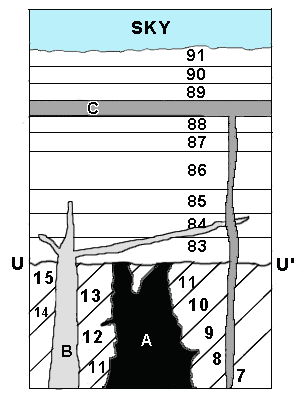 |
| SEQUENCE OF EVENTSThe sequence of events that created the rocks seen on the cliff face, starting with the oldest, is interpreted as as follows,: |
| 1. Deposition and lithification of layers 7 at least through 15. Since the top of layer 15 is not present at the outcrop, strictly speaking there is no justification for saying that layers 16 and 17 were deposited. Equally, however, there is no reason to think that deposition stopped with layer 15. Indeed, more layers may have been deposited on top of layer 17. The layers of sediment, judging from their fossil content, were all deposited on the floor of the ocean. | 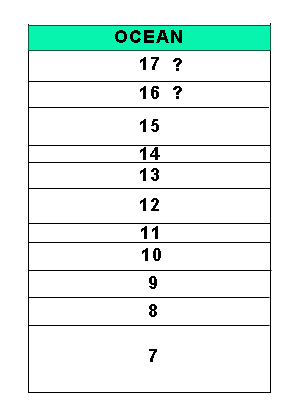 |
| 2. Tilting of the layers described above. Invoking the Law of Original Horizontality, it is assumed that the original orientation of the layers when they were deposited was horizontal. The tilting of the layers indicates they were subjected to deformational forces. The nature of those forces is not obvious. | 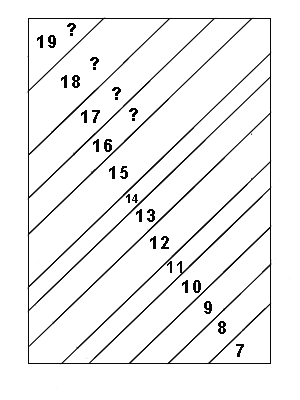 |
| 3. Intrusion of A into 7-13 and probably into one or several layers above layer 13. Invoking the Law of Cross-Cutting relationships, it is inferred that the intrusion occurred after layers 7-13 (and possibly after layers 14-19) were deposited. For an explanation of why it is assumed that the intrusion extended into layers above layer 13, see the next panel.) Furthermore, because magma tends to work its way vertically upwards, it is assumed from the general shape of the intrusion that its emplacement took place after the layers were tilted. | 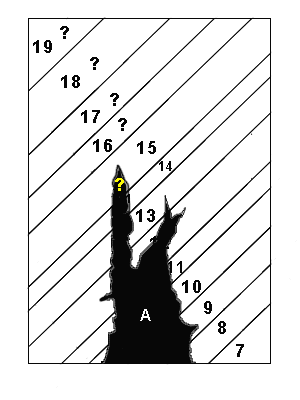 |
| 4. Erosion down to U-U'. The abrupt termination of the tilted layers and intrusion A along an irregular but generally horizontal surface (U-U') suggests that overlying material was removed by erosion. Furthermore, the rocks just under U-U' show evidence of having been weathered. If erosion has taken place down to U-U', considerable quantities of rock have been removed. Profound erosion, such as this, is generally restricted to land areas, where streams and glaciers and landslide activity are active. Floors of lakes and oceans are generally quiet places, sites of deposition rather than erosion. Since the region was ocean floor when the sedimentary layers were being deposited, for the area to become land, the whole region must have been lifted up relative to sea level. |  |
| 5. Deposition and lithification of layers 83 through 88 Judging from their fossil content, layers 83-88 were deposited on the floor of the ocean. For the area to become inundated by the ocean after being land, the region must have subsided relative to sea level. | 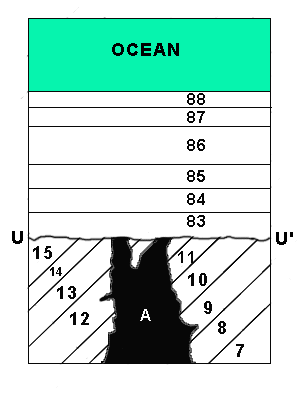 |
| 6. Intrusion of B some time after deposition of layer 85. Invoking the Law of Cross-Cutting Relationships, it is inferred that intrusion B was emplaced after the deposition of layer 85*. It is not known whether layers 86-88 were already deposited. *For the sake of simplicity it is assumed that the upper half of layer 85, which was not cut by the intrusion, was already deposited when the intrusion took place. This assumption is not completely unwarranted since if the upper half of layer 85 was not in existence, it is likely the intrusion would have emerged at the surface and spread out over over the lower half of layer 85 as a lava flow. In the absence of such a lava flow, it is likely that the upper half of layer 85 was already there. |  |
| 7. Intrusion of feeder pipe and eruption of lava flow C. Invoking the Law of Cross-Cutting Relationships, it is inferred that the feeder pipe was emplaced after layer 88 was deposited. This inference is strengtened by the Law of Superposition which demands that since the lava flow rests on layer 88, the lava flow must be younger. | 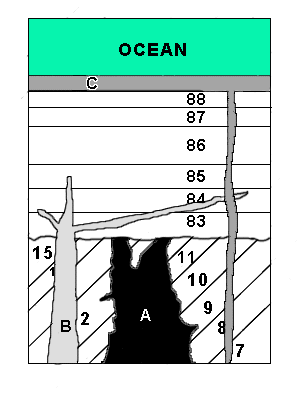 |
| 8. Deposition of layers 89-91. Judging from their fossil content, layers 89-91 were deposited on the floor of the ocean. The Law of Superposition indicates they are younger than lava flow C since they are above the lava flow.
| 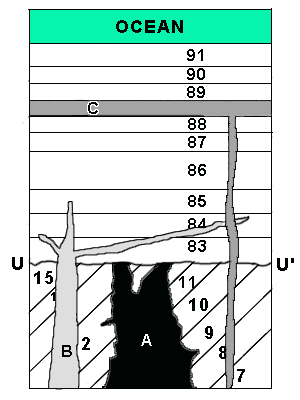 |
| 9. Erosion of part of layer 91. The irregular surface of layer 91 and the fact that it is exposed on land suggests that part of the layer has been removed by erosion. Because the region was under the ocean when layers 89-91 were deposited and is now land, the region must have been uplifted relative to sea level.
|  |
| ABSOLUTE AGES OF EVENTSThe absolute ages of the events are determined by radiometric dating of the igneous rocks and bracketing the ages of the sedimentary rocks and erosion surfaces. |
The absolute ages of igneous rocks A, B, and C are determined by radiometric dating: - A = 100 million years (my)
- B = 70 my
- C = 30 my
|
Using the Laws of Superposition, Original Horizontality and Cross-Cutting Relationships, bracketed ages of events are as follows:
- deposition, lithification and tilting of layers 7 through 15 (and possibly through 16, 17, 18, 19...) occurred before emplacement of A. These events took place before 100 million years ago (mya).
- erosion down to U-U' followed by deposition of layers 83 through 85 occurred after emplacement of A but before emplacement of B. These events took place between 70 to 100 mya.
- deposition of layers 86 through 88 took place after emplacement of A but before the eruption of C. These events took place between 30 and to 100 mya.
- deposition of layers 89 through 91 and partial erosion of layer 91 took place after the eruption of C. These events took place less than 30 mya.
| 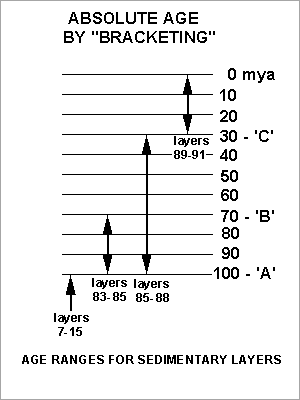 |
|
QUIZ: DECIPHERING A SAMPLE OF EARTH HISTORY
|
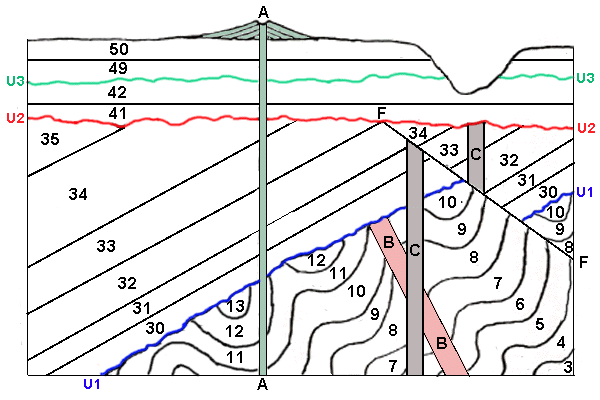
Rock ages in millions of years:
Rock 'A' = 1; Rock 'B' = 150; Rock 'C' = 75.
The numbered layers are sedimentary. 'A' is a volcano with its feeder pipe. 'B' and 'C' are igneous intrusives. Lines U1-U1, U2-U2, and U3-U3 are unconformities.  Line F-F is a fault. Line F-F is a fault. 
 Question 1: Which igneous body is the oldest?: A, B, or C. Question 1: Which igneous body is the oldest?: A, B, or C.
 Question 2: What is the number of the oldest sedimentary layer? Question 2: What is the number of the oldest sedimentary layer?
 Question 3: Arrange the following events from oldest to youngest: (a) Folding of layers 3-13. (b) Faulting along line F-F. (c) Erosion down to U1-U1. (d) intrusion of 'C'. (e) deposition of layers 30-35. (f) intrusion of 'B'. Question 3: Arrange the following events from oldest to youngest: (a) Folding of layers 3-13. (b) Faulting along line F-F. (c) Erosion down to U1-U1. (d) intrusion of 'C'. (e) deposition of layers 30-35. (f) intrusion of 'B'.
 Question 4: What is the age of layer 32 in millions of years? Of layer 42? Of layer 7? Of unconformity U3-U3? Of unconformity U2-U2? Of unconformity U1-U1? Of fault F-F? Question 4: What is the age of layer 32 in millions of years? Of layer 42? Of layer 7? Of unconformity U3-U3? Of unconformity U2-U2? Of unconformity U1-U1? Of fault F-F?
|
|
|
DRAWING CONCLUSIONS ABOUT PAST ENVIRONMENTS
|
|
In the example just discussed, the presence of fossils in sedimentary layers 7-15 and 83-91
that resemble modern ocean-dwelling organisms was used to infer that the layers were deposited on the floor of an ancient ocean. In the same example, the presence of a gap in the sedimentary record between layers 15 and 83 (unconformity U-U'), suggested the ocean had withdrawn. In an earlier discussion, the resemblance between an unlayered, unsorted sedimentary layer resting on a grooved surface and deposits of sediment laid down by modern glaciers was used to infer the past presence of glaciers. The use of analogy to draw conclusions about past organisms and sediments by reference to modern organisms and sediment is based on the assumption that the present is the key to the past. If that assumption is accepted, then careful examination of fossils and sedimentary rocks can, with appropriate caution, be used to reconstruct environmental conditions that prevailed at the surface of the earth in times past. The distribution of equivalent marine fossil assemblages over a wide area can be used to infer an ancient ocean. Many outcrops of what is assumed to be glacial sediment of the same age scattered over a wide area may reasonably be interpreted as the result of an earth that was in the grip of an ice age. Extensive sand dune cross-bedding may indicate desert conditions. Fossil palm trees invoke a tropical climate. And so on. Modern paleoclimatologists, scientists who study ancient climates, have developed a vast array of sophisticated techniques to achieve their goals. Working with geochronologists, paleoclimatologists can assign ages to the climates they have determined. One result of their research emerges in the form of graphs that plot time vs. temperature. These graphs play a key role in the effort to understand causes of climate change and to predict future climate change. They may be pivotal in the final investigation of the term: 'The Drowning of New York".

|